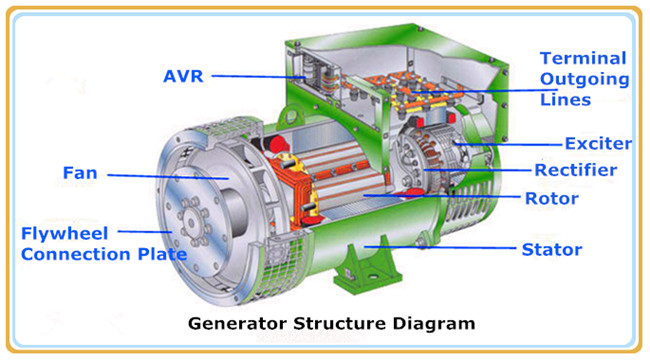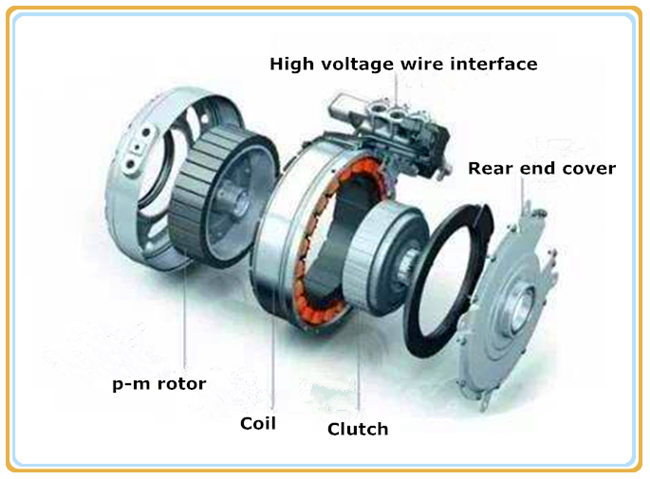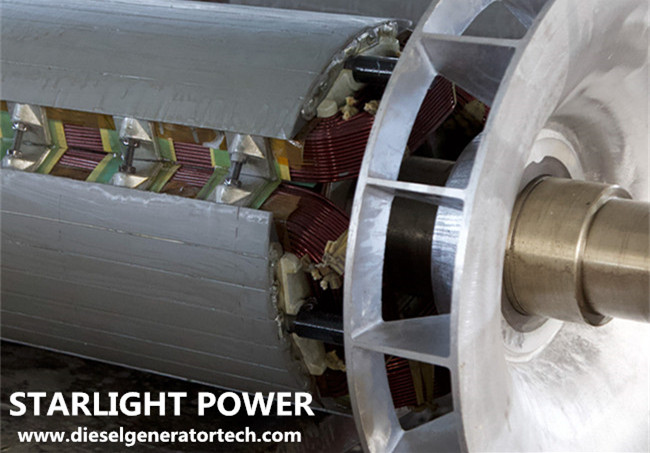A generator is a device that converts mechanical energy into electrical energy.
Synchronous Generator, that is, an alternator (AC generator) with the same rotor speed as the rotating magnetic field of the stator. According to the structure, it can be divided into two types: rotating armature and rotating magnetic field.
Synchronous generator is one of the most commonly used alternators. In the modern power industry, it is widely used in hydropower, thermal power, nuclear power generation and diesel power generation.
The external characteristics of the synchronous generator generally refer to the curve of the voltage change of the generator terminal when the load current changes under the condition of the constant internal potential. The test is mainly to test the vertical axis synchronous reactance of the generator, that is, the internal impedance of the generator. It is an important indicator of the synchronous generator with load capacity. However, the thyristor fast excitation and damper windings are mostly used in synchronous generator, and the vertical axis synchronous reactance is mostly transient value, which is far less than the steady state value.
In addition, due to the regulating effect of the excitation system, the external characteristics can be artificially manufactured, which can be positive or negative. The positive external characteristic is that the terminal voltage decreases with the increase of the load current, and the negative is that the voltage of the terminal increases with the increase of the load current. The general excitation system can be adjusted within the range of plus or minus 15%.
Since the synchronous generator generally uses DC excitation, when the single machine operates independently, the voltage of the generator can be adjusted conveniently by adjusting the excitation current. If it is incorporated into the power grid, the voltage cannot be changed because it is determined by the grid. The result of adjusting the excitation current at this time is to adjust the power factor and reactive power of the motor.
The characteristics of synchronous generator are mainly no-load characteristics and load operation characteristics. These characteristics are the important basis for users to choose generators.
Rotating magnetic pole
(Most synchronous generators): The pole is on the rotor and the armature winding is on the stator. The rotor is further divided into:
Hidden pole: high speed motor (steam turbine), distributed winding;
Salient pole: low speed motor (hydroturbine), concentrated winding.
Rotating armature
(small capacity or special purpose, such as synchronous motor AC exciter): the magnetic pole is on the stator and the armature winding is on the rotor.
The voltage change rate of the synchronous generator is about 20 to 40%. Both industrial and household loads require a constant voltage. For this reason, as the load current increases, the excitation current must be adjusted accordingly.
The structure of synchronous generator is divided into high speed and low (medium) speed according to its speed.
The former is mostly used in thermal power plants and nuclear power plants; the latter is mostly linked to low-speed turbines or diesel engines. In structure, high-speed synchronous generator uses hidden pole rotor, and low (medium) speed synchronous generator uses salient pole rotor.

(1) Establishment of the main magnetic field: the excitation winding is connected with the DC excitation current to establish the excitation magnetic field between the polar phases, that is, the main magnetic field is established.
(2) Current-carrying conductor: Three-phase symmetrical armature winding acts as power winding and becomes a carrier of inductive potential or induced current.
(3) Cutting motion: The prime mover drives the rotor to rotate (Input mechanical energy to the motor), and the excitation magnetic field between the polar phases rotates with the axis and sequentially cuts the stator phase windings.
(4) Generation of alternating potential: Due to the relative cutting motion between the armature winding and the main magnetic field, the three-phase symmetric alternating potential whose magnitude and direction change periodically will be induced in the armature winding. AC power can be provided through the lead wires.
(5) Effect value of Inductive potential: the effective value of the induced potential of per phase.
(6) Induced potential frequency: The frequency of the induced potential is determined by the rotational speed and the pole pairs of the synchronous motor.
(7) Cross-change and symmetry: Due to the polarity of the rotating magnetic field, the polarity of the induced potential is alternating; the symmetry of the armature winding ensures the three-phase symmetry of the induced potential.
(8) Synchronous speed from the viewpoint of power supply quality, the frequency of the AC power grid composed of many synchronous generators in parallel should be a constant value, which requires that the frequency of the generator should be consistent with the frequency of the grid.
Difference between synchronous generator and asynchronous generator
Synchronous Generator
Advantages: The power factor of synchronous generator can be adjusted. The application of a large synchronous generator can improve the operating efficiency when the speed regulation is not required.
Disadvantage: The cost is higher than that of asynchronous generator.
Application: Synchronous generator is mainly used in diesel generator set.
Asynchronous generator
Asynchronous generator is an alternator that utilizes air gap rotating magnetic field between stator and rotor to interact with induced current in rotor winding. According to its working principle, it is also called "induction generator". The speed is slightly higher than the synchronous speed.

Advantages: An asynchronous generator is an AC generator whose ratio of the speed of the load to the frequency of the connected power grid is not constant. Therefore, it has the advantages of simple structure, convenient manufacture, use and maintenance, reliable operation, and low cost. Asynchronous generators have higher operating efficiency and better working characteristics, which can meet the transmission requirements of most industrial and agricultural production machinery because of its close to constant speed in the range from no load to full load.
Disadvantage: Since the speed of the asynchronous generator has a certain difference with the rotational speed of the magnetic field, the speed regulation performance is poor. It is more economical and convenient to use DC generators for transportation machinery, rolling mills, large machine tool, printing and dyeing and papermaking machinery that require a wide and smooth speed range.
Application: Asynchronous generator is used in wind power plants and small hydropower station.
Note: We can provide original Stamford, Leroy-Somer, SIEMENS, Marathon, ENGGA, Shanghai KEPU and Starlight synchronous generator for power equipment.

Copyright © Guangxi Dingbo Generator Set Manufacturing Co., Ltd. All Rights Reserved | Sitemap
Update cookies preferences